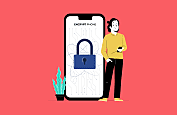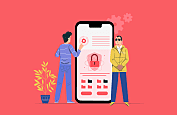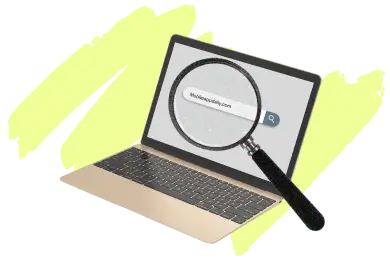

These days, email plays a major role in our lives. We chat about it for work-related matters as well as with friends and family. However, since we use email so frequently, malevolent individuals—hackers—often attempt to access our accounts. It can be difficult to fix if they get in. However, be at ease! This article aims to assist you in regaining access to and safeguarding your email account.
68% of the approximately 100 million phishing emails that Gmail filters stopped were part of an unseen scheme. Most phishing emails don't have a subject (the title). If you find out someone is using your email, act fast to stop them. Hackers might pretend to be you, get your personal or financial details, or send fake emails to people you know. In addition to monitoring any unusual activity related to your email, there are several obvious indicators that someone else has gained access to your account.
Now let's get started and discover how to recover a hacked email from those cunning hackers!
Understanding the Landscape: Key Statistics on Email Account Hacking

- According to Deloitte, an unsuspecting target receives a phishing email in 91% of all cyberattacks.
- According to data on phishing emails, around 1.2% of all emails sent are malicious. This translates to 3.4 billion phishing emails sent every day. One email received out of every 4,200 would almost certainly be a phishing scheme.
- In a single year, around 1 billion emails were compromised, impacting 1 in 5 internet users.
- Every year, hackers were able to take $4.91 billion in emails from companies.
- In the US, 12% of users click on malicious links and 30.1% of people open phishing emails.
How to Know If Your Email Has Been Hacked?
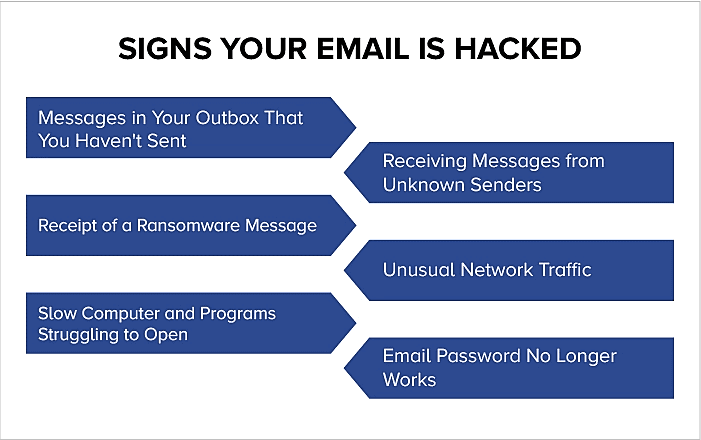
To secure your account and safeguard your data; you must act right once if you believe your email has been compromised. You can protect your emails in many ways, like using a VPN when booking a hotel accommodation or simply using a stronger password. The indicators that your email may have been compromised are explained in full below, as they were in your list:
1. Messages in Your Outbox That You Haven't Sent
If hackers are able to access your email account, they might use it to spread spam, phishing scams, and malware to your contacts. Your hacked email can even send the message to random email addresses. You might see these emails appear as sent in your outbox. An important indicator that your account has been hijacked is finding emails in your outbox that you do not recall sending.
2. Receiving Messages from Unknown Senders
Email accounts used for unsanctioned message sending are suspect if you begin to receive answers or messages from individuals you do not know or did not start a conversation with. Hackers may send phishing emails to other people using your account, and the confused receivers respond to you.
3. Receipt of a Ransomware Message
Getting a ransomware message is a clear sign that your email has been hacked. These messages often ask for money to unlock your files and threaten to lock your account if you don't pay. This suggests that malware has been placed on your device in addition to the hacking of your email.
4. Unusual Network Traffic
Increased network activity may indicate malicious activity on your computer, particularly if you're not using your Internet connection often. Hackers could use your device to send unsolicited emails or carry out other illegal actions, which would cause strange network activity. To enhance your security, especially after recovering from such incidents, consider using one of the best authenticator apps available.
5. Slow Computer and Programs Struggling to Open
Hacker-infected email accounts might introduce malware that uses up your computer's resources and drastically reduce its speed. Malware may be operating in the background if your device starts to lag and apps open more slowly than usual.
6. Email Password No Longer Works
If your email password stops functioning even though you are positive that you are typing it correctly, there's a good chance that someone else has stolen your account and changed the password to prevent you from accessing it. This is frequently one of the first things a hacker does to make sure they can access an account without permission.
Step-By-Step Restoration: How To Recover A Hacked Email
After your email has been compromised, you must take a few important measures to secure and restore access. Understanding hacked email account recovery will help you stop similar incidents in the future. You must take quick action and proceed carefully to ensure your email and personal data are safeguarded. Use the email security best practices and cybersecurity tips to secure your privacy.
| Step | Example |
|---|---|
| Step 1: Regain Access to Your Account | Don't panic if the hacker modifies your password and you are unable to access your account. You can usually retrieve it with the help of most email services. They may ask for proof of identity, such as a previous phone number or email address. Simply follow the instructions, which may include answering some account-related questions or entering a code they provide to your phone. |
| Step 2: Change Your Password | You should change your password to something strong that combines letters, numbers, and symbols as soon as you get access back to your account. One of the greatest password manager programs should be used to handle this efficiently and keep personal information like names and birthdays out of it. |
| Step 3: Enable Two-Factor Authentication (2FA) | Your email account's security can be increased by turning on two-factor authentication. This calls for more verification than just your password, such as getting a code sent to your phone. Even in the unlikely case that your password is guessed, 2FA dramatically lowers the danger of unwanted access. |
| Step 4: Check Account Settings and Activity | Verify the settings of your email account to see if the hacker made any changes. Hackers might copy and send your emails. This might be altered to send email answers to the hacker's address. Make sure your email address and phone number are correct and up to date. Furthermore, look over the last few activities on your account for any strange logins or actions. |
| Step 5: Scan Your Computer for Malware | Hackers utilize malware, and software, to access email accounts without authorization. Your computer is scanned for viruses by an antivirus application. If it discovers any, it notifies you and stores them securely. For your antivirus program to be able to identify more recent computer infections, make sure it is updated frequently. Use reliable antivirus software to perform a thorough system inspection. Delete viruses and malware immediately to prevent them from tracking keystrokes or returning data to the hacker. |
| Step 6: Notify Your Contacts | Inform your contacts that your email has been compromised. This is necessary to protect them against malware that spreads from your hacked account and phishing fraud. |
| Step 7: Secure Linked Accounts | Your email address may be connected to other accounts on social networking, e-commerce, or banks. Make sure to change the passwords for both your email and these accounts if you use the same one. Check these accounts for any unusual activity as well. |
| Step 8: Monitor Your Email Account | It's critical to keep an eye out for any indications of strange activity after safeguarding your account. It's crucial to monitor your postal things, account settings, and past logins. The best email programs can also improve your security and productivity by providing you with cutting-edge technologies that improve your ability to identify and notify you of suspicious activity. |
Let us now dive to learn the steps:
Step 1: Regain Access to Your Account
If the hacker changes your password and you can't get into your account, don't worry. Most email services have a way to help you recover it. They might ask you to prove it's you by using a phone number or email you've used before. Just follow the steps they give you, like entering a code they send to your phone or answering some questions about your account.
Step 2: Change Your Password
When you regain access to your account, it's crucial to change your password immediately to something strong, incorporating a mix of letters, numbers, and symbols. To manage this effectively and avoid using personal details like names or birthdays, consider utilizing one of the best password manager apps.
Step 3: Enable Two-Factor Authentication (2FA)
Enabling two-factor authentication can enhance the security of your email account. This requires an additional verification method, such as a code texted to your mobile device and your password. The risk of unauthorized access is significantly reduced with 2FA, even if your password is discovered.
Step 4: Check Account Settings and Activity
Check your email account settings for any modifications the hacker may have done. Give special consideration to:
- Email forwarding settings: Your emails could be copied and sent to hackers.
- Reply-to email address: This might be changed to send the hacker's address the replies to your emails.
- Recovery information: Ensure your phone number and email are up-to-date and accurate.
- Additionally, check your account's recent activity for unusual logins or actions.
Step 5: Scan Your Computer for Malware
Malware is a type of software that hackers use to get into email accounts without permission. An antivirus program checks for viruses on your computer. If it finds any, it puts them in a safe place and tells you about it. Make sure your antivirus is updated regularly to ensure it can detect newer computer viruses. Use trustworthy antivirus software to do a complete system check. To stop viruses or malware from recording keystrokes or sending data back to the hacker, remove them immediately.
Step 6: Notify Your Contacts
Notify your contacts that someone has compromised your email. This is essential to shield them against phishing scams and malware disseminated from your account while it was compromised.
Step 7: Secure Linked Accounts
Your email might be linked to other accounts like social media, online shopping, or banking. If you use the same password for these accounts and your email, change them too. Also, check these accounts for any suspicious activity.
Step 8: Monitor Your Email Account
After securing your account, it's crucial to remain vigilant for any signs of unusual activity. Regularly monitoring your mailed items, account settings, and login history is essential. Additionally, considering the use of the best email apps can enhance your security and efficiency, offering advanced features to detect and alert you of suspicious activities more effectively.
Securing the Account After Recovery
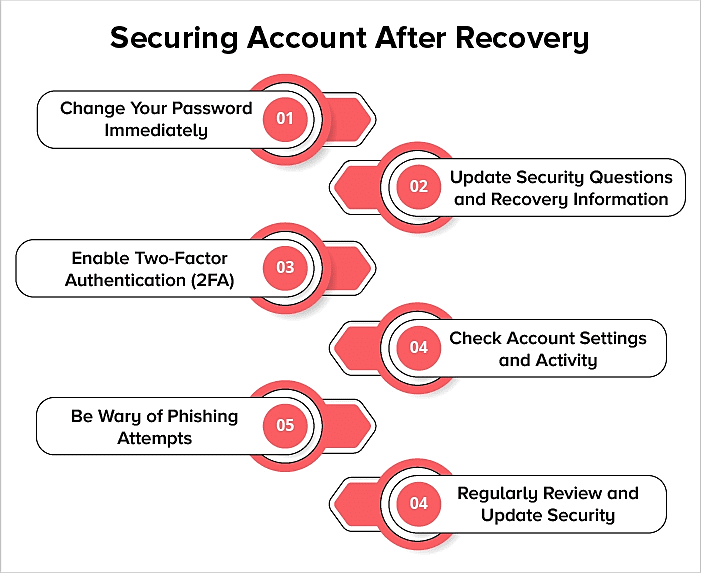
After hacked email account recovery, maintaining the security of your email account requires not only quick fixes but also a watchful, knowledgeable approach to security. You may greatly lower the likelihood of future intrusions by adhering to these guidelines and remaining informed about the most recent cyber threats. Recall that you are responsible for your own security in the digital world.
1. Change Your Password Immediately
Change your password first thing in the morning. Select a strong, one-of-a-kind password using a combination of characters, digits, and symbols. Don't use information that can be guessed, such as birthdays or everyday terms. Your first layer of protection is a strong password.
2. Update Security Questions and Recovery Information
Next, ensure your recovery information and security questions are current and reviewed. Select inquiries that only you possess the answers to. Make sure your phone number and recovery email are current. You need this information in order to get back in if you've been locked out.
3. Enable Two-Factor Authentication (2FA)
Two-factor authentication makes your account even safer. After you enter your password, you'll get a special code on your phone or email. This stops others from entering your account, even if they know your password. Turn on 2FA—it really helps protect data from hackers.
4. Check Account Settings and Activity
Look at the choices for your account. See if there are any changes you didn't make, like altering your details or sending emails to strange addresses. Also, check for any odd logins recently. Doing these things helps ensure that hackers can't get in through any hidden ways.
5. Be Wary of Phishing Attempts
Learn about phishing schemes. People are frequently duped by hackers into disclosing personal information. Emails requesting personal information or advising you to click on links should raise suspicions. Never click if you're not sure. Use another method to confirm the sender.
6. Regularly Review and Update Security
Make a habit of checking and changing your email password regularly to stay safe. Being proactive is key to protecting your account. You need to update your defenses as hackers change their tactics, including using the best VPN apps to secure your online activities. Follow the latest security tips to keep your account safe.
Preventative Measures for Future Protection
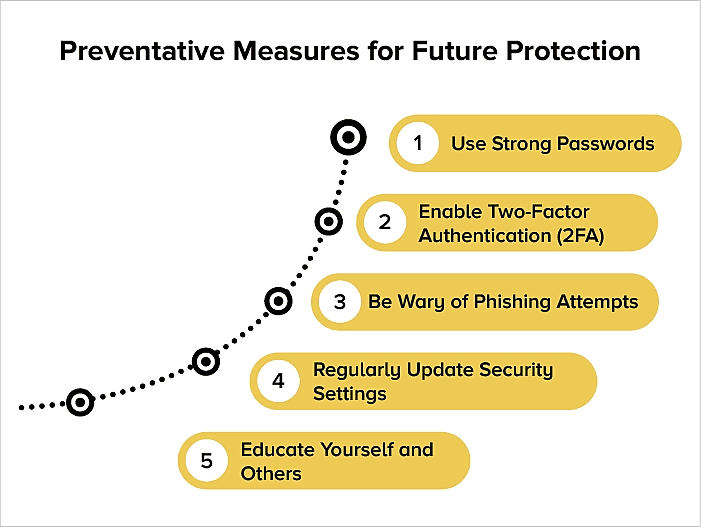
In the current digital era, where personal and professional information is regularly shared over email, preventing email hacks is essential. By being proactive, you can drastically lower the possibility of unwanted access to your account. Here's how to protect your email:
1. Use Strong Passwords
Making strong passwords is simple but very effective for keeping your email safe. A good password mixes letters, numbers, and symbols, like 'Pa$5w0rd!' or 'P@55w0rd!'. Avoid using the same password for different sites. If you struggle to remember them, consider using a trusted password tool.
2. Enable Two-Factor Authentication (2FA)
Two-factor authentication adds extra security to your account by asking for more than just your password. It might be a special code from an app or sent to your phone. Without this extra code, even if someone knows your password, they can't enter your account.
3. Be Wary of Phishing Attempts
Watch out for phishing scams online, a critical reminder why adhering to email marketing best practices is essential for businesses to maintain trust. These scams are tricks where someone pretends to be trustworthy to get your private information. Before opening attachments or clicking links, double-check that the email is from the right sender.
4. Regularly Update Security Settings
Keep an eye on your email's safety settings often. Make sure your phone number and backup email are up-to-date. If you ever need to regain your account, having the right info is super important. Also, see what devices and apps can get into your account and remove any you don't need or recognize.
5. Educate Yourself and Others
Stay updated on the latest online dangers, and share this information with people you know. Being aware of these threats makes it less likely for you to be targeted by hackers. Many email companies and groups on online safety offer helpful tips and warnings about new scams and risks.
Closing Remarks: Safeguarding Your Email Account
Hacked email account recovery necessitates quick thinking and effort to protect your online privacy. In the process of securing your account, you might find your inbox flooded with spam or malicious emails as a result of the hack. Learning how to mass delete emails on Gmail can help you efficiently clear out these unwanted messages and regain control.
You can reduce harm by changing your password quickly, protecting your account settings, and adding extra security like two-factor authentication. It's important to watch for signs of more illegal activity.
Ensure you know about the latest online dangers and how to stay safe. Keep your safety rules up to date with email Account protection strategies. Watch out for fake emails that trick you so your email stays safe from hackers. Remember, the best way to stay safe from email problems is to be careful and know what to do. Ensure you're ready to move quickly if someone gets into your account. Keeping your email safe means paying close attention and being flexible to handle new online dangers.
Frequently Asked Questions
-
How do I know if my email has been hacked?
-
What to do if your email is hacked?
-
What steps can I take to prevent my email from being hacked?
-
Is it safe to use my email after it's been hacked?
-
How long does it take to recover a hacked email account?
-
Can I trace who hacked my email account?
-
Can I recover a hacked email account?
-
How can I protect my email from future hacks?











